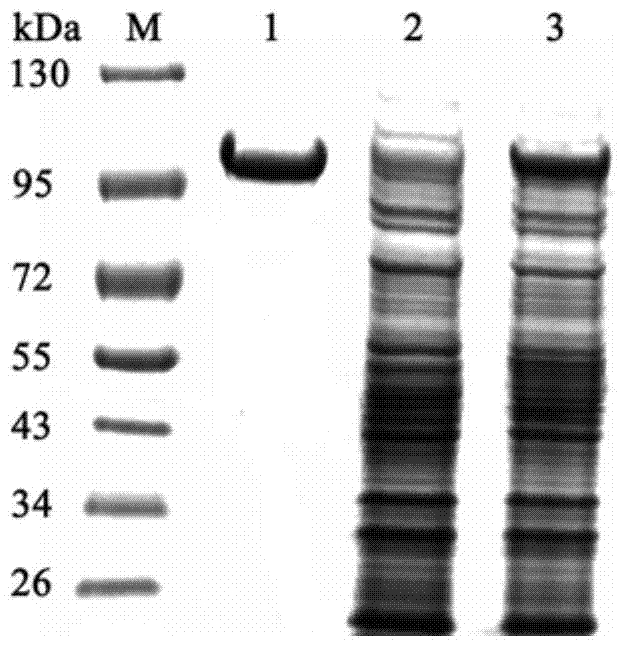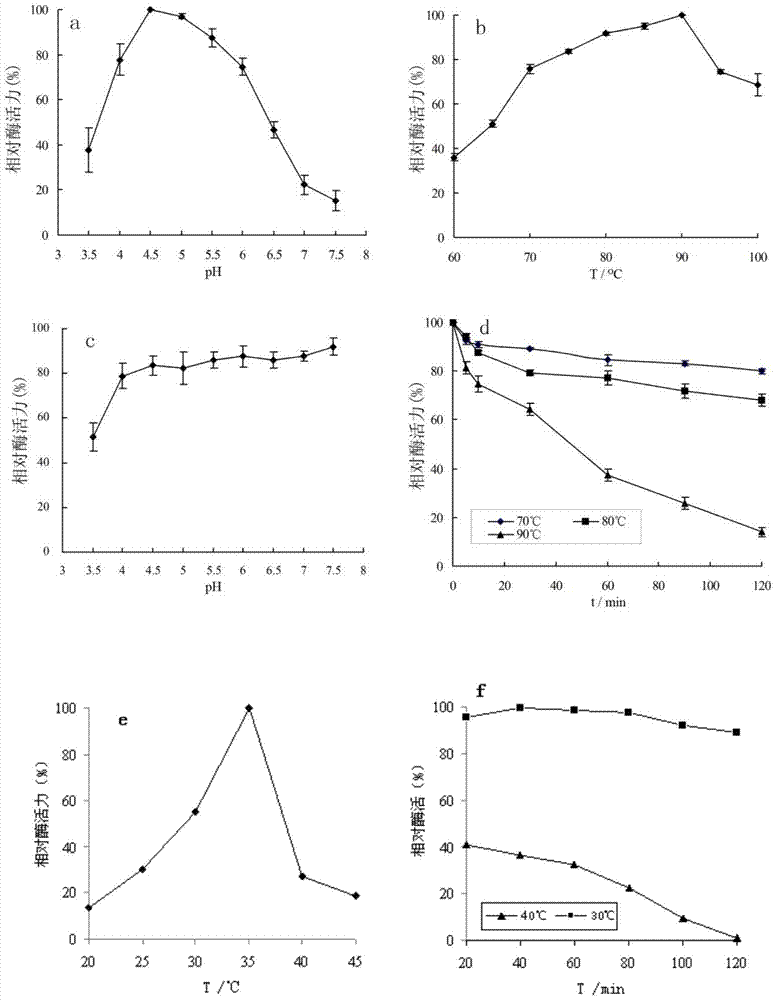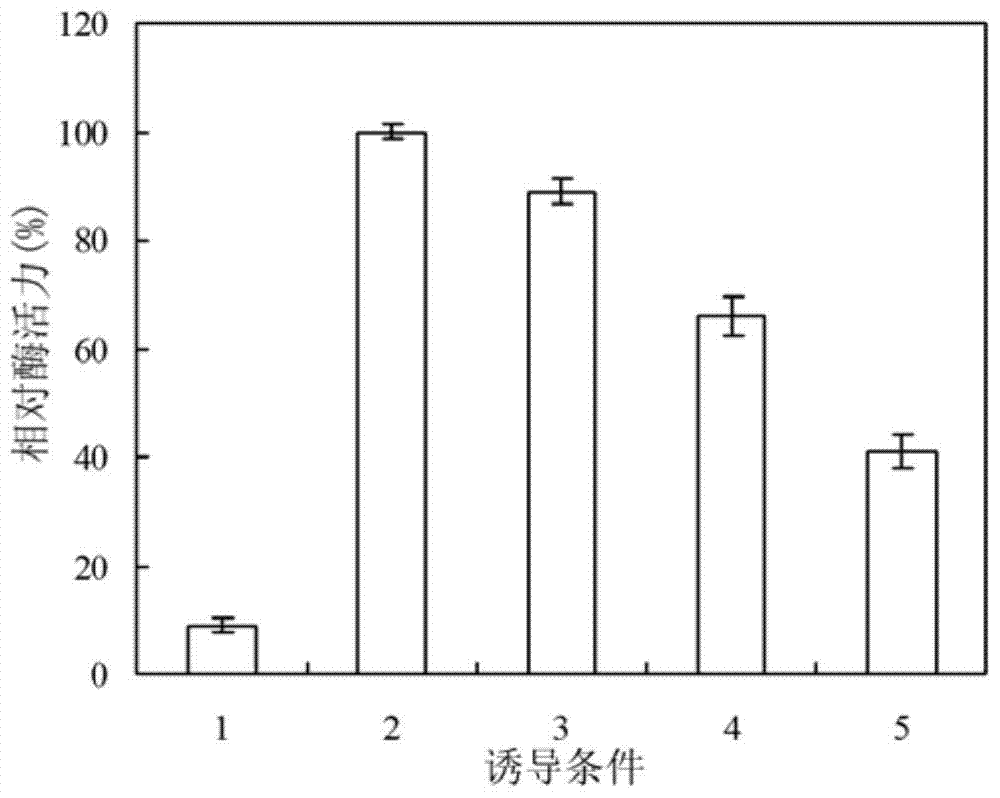A kind of α-rhamnosidase and its preparation method and application
A rhamnosidase and glycoside rat technology, which is applied in the fields of genetic engineering technology and biomedicine, can solve the problems of high thermal stability, reduced yield of the target product, low reaction temperature, etc., and achieves excellent thermal stability and optimal reaction. The effect of high temperature and high expression
- Summary
- Abstract
- Description
- Claims
- Application Information
AI Technical Summary
Problems solved by technology
Method used
Image
Examples
Embodiment 1
[0032] Embodiment 1: the acquisition of α-rhamnosidase gene of the present invention and the construction of recombinant plasmid pET-TPERha
[0033] 1.1 Thermotoga petrophila Culture of DSM 13995
[0034] Thermotoga petrophilaDSM 13995 was purchased from the DSMZ Culture Collection Center (www.dsmz.de) with the number 13995, and its medium formula was: 10 g / L starch, 5 g / L tryptone, 3 g / L yeast extract, 5 g / L L meat extract, 10 g / L 2-morpholineethanesulfonic acid, 10 mg / L ferric sulfate heptahydrate, 1 mg / L resazurin, and adjust the pH to 7.2. Inoculate with a syringe according to the inoculum volume of 0.5 wt.% medium, culture statically at 85°C for 24 h, and collect the cells.
[0035] 1.2 Extraction of genomic DNA
[0036] (1) Statically culture Thermotoga petrophila DSM 13995 for about 24 hours, take 30 mL of bacterial liquid and centrifuge at 4,000 g for 10 min to collect cells.
[0037] (2) Resuspend the cells in 9.5 mL TE buffer, add 0.5 mL 10 wt.% sodium dodecy...
Embodiment 2
[0052] Embodiment 2: the preparation of α-rhamnosidase of the present invention
[0053] The recombinant plasmid pET-TPERha was transformed into Escherichia coli JM109(DE3) host bacteria (purchased from Novagen), and placed on an LB plate containing kanamycin (50 μg / mL) (LB medium: tryptone 10 g / L, yeast Extract 5 g / L, NaCl 5 g / L, agar 15 g / L) after culturing overnight at 37°C, pick the transformant into 200 mL of LB medium (50 μg / mL kanamycin) at 37°C, 200 Shake the culture at rpm until the OD600 is 0.6, add a final concentration of 0.5 mM isopropyl β-D-thiogalactopyranoside (IPTG) inducer, culture at 30°C for 6 h, and use a high-speed refrigerated centrifuge to distill the culture solution in Centrifuge at 13,000 rpm for 15 min at 4°C to collect the cells.
[0054] Since the recombinant plasmid pET-TPERha contains a His-tag tag, it was purified by His•Bind Purification Kit (purchased from Novagen) to obtain a purified recombinant enzyme. Specific operation process:
[005...
Embodiment 3
[0071] Embodiment 3: the qualitative determination of α-rhamnosidase of the present invention
[0072] 1. Determination method of enzyme activity
[0073] Reaction system 100 μL, 5 μL 20 mmol / L p-nitrophenyl-α-L-rhamnoside ( p Add 85 μL of 100 mmol / L citric acid-sodium hydrogen phosphate buffer (pH 6.0) to NPR), incubate at 90°C for 3 minutes, then add 10 μL of enzyme solution (diluted to an appropriate multiple) for 10 minutes, and develop color Then add 600 μL of 1 mol / L sodium carbonate solution to terminate the reaction. Absorbance was measured at 405 nm. Enzyme activity unit (U) is defined as: under assay conditions, produce 1 μmol per minute p - The amount of enzyme required for nitrophenol is 1 enzyme activity unit.
[0074] 2. Determination of the optimum reaction pH
[0075] Under the conditions of different pH (3.5-7.5, 100 mmol / L citric acid-disodium hydrogen phosphate buffer), the enzyme activity was measured at 90°C, and the results were as follows figure 2...
PUM
 Login to View More
Login to View More Abstract
Description
Claims
Application Information
 Login to View More
Login to View More - R&D
- Intellectual Property
- Life Sciences
- Materials
- Tech Scout
- Unparalleled Data Quality
- Higher Quality Content
- 60% Fewer Hallucinations
Browse by: Latest US Patents, China's latest patents, Technical Efficacy Thesaurus, Application Domain, Technology Topic, Popular Technical Reports.
© 2025 PatSnap. All rights reserved.Legal|Privacy policy|Modern Slavery Act Transparency Statement|Sitemap|About US| Contact US: help@patsnap.com



